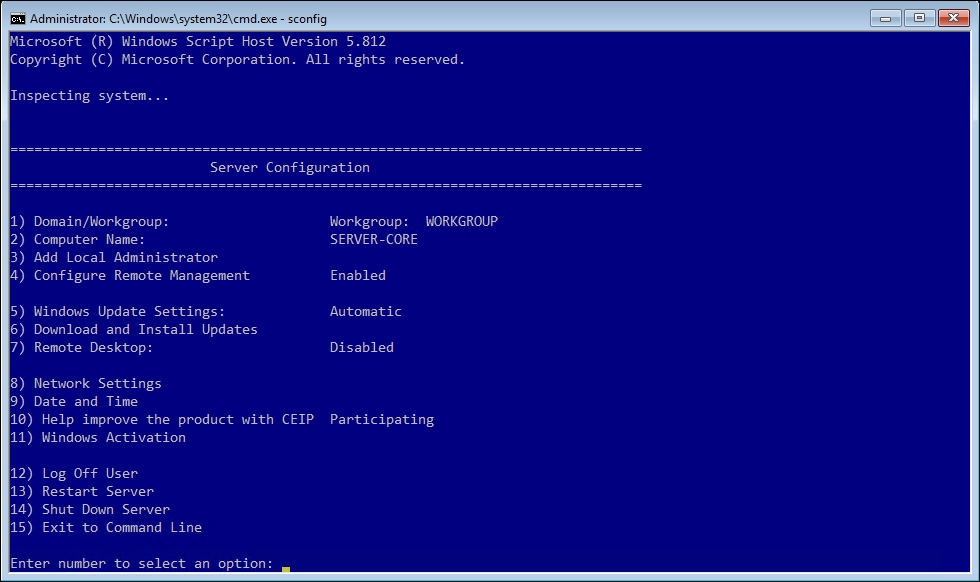Managing a Server Core installation using sconfig
In the previous recipe, you read about all the benefits of Server Core, such as performance, security, and so on. However, it's not easy to do the daily management and maintenance of Hyper-V without GUI. If you want to change the computer name or the IP address, the GUI is always the easiest to use. But on the other hand, the command line can bring about a fast and automated process.
That's why in Windows Server 2016, the Server Core version of Windows and Microsoft Hyper-V Server 2016 comes with the Server Configuration (sconfig). This is a command line with a simple interface to reduce the time for doing the most common tasks in Windows. In the following screenshot, you can see an example of the first page of sconfig:

The sconfig tool can do this via an intuitive numerical menu to facilitate the Windows configuration.
A simple example is when you have to change the IP address of your computer using the command line. Take a look at the following command:
netsh interface ip set address "Local Area Connection" static 192.168.0.10 255.255.255.0 192.168.0.1 1
Sometimes it is hard to remember the exact command syntax and this can lead to server misconfiguration.
Using sconfig, the process would be simply to press the numbers 8, 0, and 1 from the menu and simply specify the new IP configuration. That's it.
In this recipe, you will learn how to set up the most common configurations in your Server Core without advanced command lines.
Getting ready
The Server Configuration tool is added by default on a Server Core installation or Hyper-V Server. Just type sconfig in the command line and the menu will be loaded.
How to do it...
In order to manage the server core installation using sconfig, carry out the following steps:
To change the domain/workgroup settings, press 1.
Press D for domain or W for workgroup.
Specify the domain or workgroup name, the necessary username and the password, and then press Enter.
To change the computer name, press 2 and specify the new computer name.
Select Yes to restart the computer.
Press 3 to add a local administrator.
Enter the account to join the local administrators group and type the user password.
To configure the remote management, press 4.
Select one of the following options:
Allow MMC Remote Management
Enable Windows PowerShell
Allow Server Manager Remote Management
Show Windows Firewall settings
Press 5 to change Windows update settings and Select A for automatic or M for manual.
Press 6 to download and install updates.
Select A for all updates or R for recommended updates only.
To enable remote desktop, press 7. Select E to enable or D to disable.
Press 8 to configure network settings.
Select the network adapter number you want to configure and then select one of the existing options:
Set network adapter IP address
Set DNS Servers
Clear DNS Server Settings
To change the date and time, press 9 and a graphical interface will show up with the date and time settings to be configured.
To restart and shut down the server:
Press 1+0 to join Customer Experience Improvement Program
Press 1+1 for logoff
Press 1+2 to restart the computer
Press 1+3 to shut down the server
Press 1+4 to exit to command line
After these configurations using
sconfigand with reduced command line interaction, your server will be ready for the production environment.
How it works...
Server Configuration basically runs scripts in the background for every option that has been selected through a numeric menu, making your life much easier. For every number you select, sconfig can run another script to show a submenu or just run the final script to apply the changes you have selected.
See also
The Hyper-V management and PowerShell improvements recipe in Chapter 4, Saving Time and Cost with Hyper-V Automation.












































































